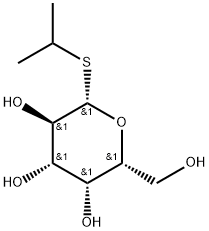Description
IPTG (also known as Isopropyl-β-D-Thiogalactopyranoside) is a molecular biology reagent that functions as an inducer of galactosidase activity by binding to and inhibiting the repressor. It is a molecular mimic of allolactose, a lactose metabolite that triggers transcription of the lac operon, and it is therefore used to induce protein expression where the gene is under the control of the lac operator. IPTG cannot be hydrolyzed or broken down by the E. coli therefore the concentration remains constant during cell replication. IPTG is often used at a final concentration ranging from 0.5-1.0 mM. X-Gal is often used with IPTG since it provides an easy visual method to monitor whether protein expression has occurred. X-Gal as the name implies contains a galactose group that once metabolized causes a bright blue color change.
Chemical Properties
White crystalline powder
Uses
Isopropyl-β-D-thiogalactoside is used as a reagent in molecular biology. It is used as an effective β-galactosidase inducer of protein expression where the gene is under the control of the lac operator. It is used with 5-bromo-4-chloro-3-indolyl-beta-D-galactopyranoside to identify the non-recombinant plasmid in cloning experiments by blue-white screen methodology.
Preparation
a synthetic method of isopropyl-β-D-thiogalactoside. The steps are as follows:
Step 1: Dissolve β-D-galactose pentaacetate in any organic solvent of methylene chloride, chloroform or 1,2-dichloroethane, and add Lewis acid (boron trifluoride ether, (Aluminum trichloride, zinc chloride) catalyst and potassium ethylxanthate or sodium ethylxanthate are reacted to obtain tetraacetylgalactose ethylxanthate after treatment.
Step 2: Dissolve tetraacetyl galactose ethyl xanthate, 2-bromopropane and sodium carbonate in methanol or ethanol at a temperature of 20°C to 80°C and react for 4-6 hours to obtain isopropyl group after treatment Isopropyl-β-D-thiogalactoside.

Application
IPTG (Isopropyl-β-D-thiogalactopyranoside) is a galactose analogue not recognized by β-galactosidase. IPTG is a non-metabolizable galactose analog that induces expression of the lac operon in Escherichia coli. It is a commonly used reagent in cloning procedures that require induction of b-galactosidase activity and is used in conjunction with X-Gal. It is commonly used in cloning procedures that require induction of β-galactosidase activity. It is also used in conjunction with X-Gal or Bluo-Gal in blue-white selection of recombinant bacterial colonies that induce expression of the lac operon in Escherichia coli. IPTG functions by binding to the lacI repressor and altering its conformation, which prevents the repression of the β-galactosidase coding gene lacZ.
Definition
ChEBI: Isopropyl beta-D-thiogalactopyranoside is an S-glycosyl compound consisting of beta-D-1-thiogalactose having an isopropyl group attached to the anomeric sulfur.
General Description
Inducer for β-galactosidase, an enzyme that promotes lactose utilization. Use in conjunction with X-Gal. Molecular Biology grade.
Stock solutions:
X-Gal: 20 mg/ml in DMF
IPTG: 20 mg/ml in water
Use 4:1 (X-Gal:IPTG)
Assay: ≥99%
Dioxane: None detected
Melting point: 110-114°C
Specific rotation [a]25/D (1%, water): -34.0 to -29.0°
Intended for laboratory and manufacturing use only. Not for drug, food, or household use.
Solubility in organics
IPTG is soluble in organic solvents such as ethanol, DMSO, and dimethyl formamide (DMF). The solubility of IPTG in ethanol and DMSO is approximately 20 mg/ml and approximately 30 mg/ml in DMF.
storage
Store powder at -20°C away from direct sunlight. Once opened and recapped, place container in a low humidity environment at the same storage temperature. Protect from moisture and light by keeping container tightly closed.







